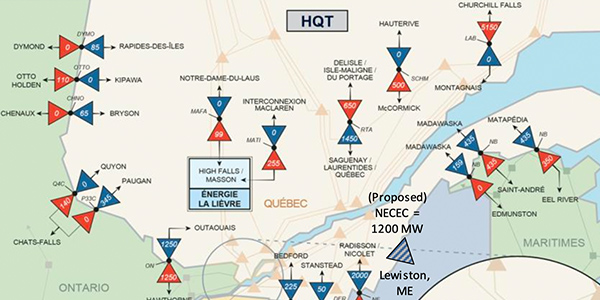Blackstone Group’s Champlain Hudson Power Express (CHPE) transmission project has made allies of power producers and environmentalists, both of whom continue to oppose the underwater line as the deadline for comment on a permit change with state regulators passed on March 8 (Case No. 10-T-0139).
The $3 billion, 330-mile HVDC line, first proposed by Blackstone’s Transmission Developers Inc. (TDI) in 2010, would bring up to 1,250 MW of Canadian hydropower from Quebec under Lake Champlain down to New York City.

The geographical location of Québec’s interties, including two new proposed interties to support CHPE and Avangrid’s New England Clean Energy Connect | Hydro-Québec
In the past year, the developers have requested permission from the New York Public Service Commission to amend its certificate of environmental compatibility and public need three times. The PSC on Jan. 26 approved moving the line 1,200 feet in New York City to avoid the Harlem River Yard, routing it under Randall Island Park instead. It also allowed five splice vaults to be located on private land immediately adjacent to the revised right of way in Rockland County.
The developer’s latest request, on Jan. 29, was to boost the line’s capacity from 1,000 MW to 1,250 MW.
“There is a growing resistance among the climate justice and indigenous-led groups,” Meg Sheehan, campaign coordinator for the North American Megadam Resistance Alliance (NAMRA), told RTO Insider. She pointed to an op-ed published last month in the Bangor Daily News by Lucien Wabanonik, a councillor for the Nation Anishnabe of Lac Simon, titled “Hydro-Québec has left Québec’s First Nations behind.” The province-owned Hydro-Québec would develop the Canadian portion of the line.
Sheehan also noted that New York in January issued a solicitation for transmission projects to bring Tier IV renewable hydropower from upstate and Canada to New York City as part of a $2 billion green “superhighway” project. (See “Other Projects,” NY Awards 2.5-GW Offshore Deal to Equinor.)
“The Hydro-Québec power could not meet the baseline greenhouse gas reporting requirements that’s required by that request for proposals,” Sheehan said. “They would have to provide emissions data from their 63 dams, which they have not been able to do.”
The Independent Power Producers of New York (IPPNY) released a study last year, commissioned from Energyzt, that it said debunked TDI’s claims that the project would result in reduced global emissions of carbon dioxide, concluding that it “may even increase overall carbon emissions.”
“The Champlain Hudson Power Express didn’t make sense a decade ago, and it makes less sense now,” IPPNY CEO Gavin Donohue told RTO Insider. “In-state resource development must be the priority if we truly want to revitalize our economy and build back better. Expanding New York’s renewable energy industry will lead to critical jobs and taxes for communities, along with guaranteed emissions reductions. That’s a preferable outcome to subsidizing Canadian government-owned hydropower with no environmental benefit.”
Eric Johansson, executive director of the Towboat and Harbor Carriers Association of New York and New Jersey, had quoted experts who calculated “anchor penetration significantly deeper than the deepest burial depth (15 feet) proposed for the CHPE.”
The anchor is often the only tool available in an emergency, and “safe navigation will be compromised in the Hudson River by this or any cable seeking to run parallel in navigable waters,” Johansson said.
In response, the PSC advised that “final facility design, including burial depth details, will be proposed in the environmental management and construction plan to be filed, and available for the association’s review and comment.”
Drinking Water Concerns
FERC OKs Negotiated Rates for Champlain Hudson Project.)
The PSC last June ruled that no evidentiary hearing was required on the developer’s petition for a second amendment to the certificate because no party had identified any disputed issues of material and relevant fact.
“Neither NAMRA, nor the Sierra Club Atlantic Chapter, explained why the public comment period, which will extend for the pendency of this proceeding, was insufficient. Nor did they state how the proposed rerouting … would have any bearing on their comments,” the commission said.
Sierra Club had commented that “none of these [route] changes alleviate the negative impact that the entire project will have on wild Canadian rivers, disadvantaged communities in both Canada and New York City, the Hudson River Estuary, the growth of New York renewable energy jobs and the state’s climate goals under the Climate Leadership and Community Protection Act.”
NAMRA in December decried the “slipshod planning” of the project, which “has the hallmarks of an arbitrage scheme that greenwashes Canadian hydropower, threatens to make the climate crisis worse, undermines New York’s renewable energy economy and perpetuates environmental racism.”
Paul Malmrose — an engineer and technical consultant for the Hudson River Drinking Water Intermunicipal Council, a coalition of seven municipalities that draw drinking water from the river in Dutchess and Ulster Counties — had raised concerns about the construction-related risk of the project, as “jet plowing will turn up contaminated sediments with heavy metals, [polychlorinated biphenyls], pesticides and petroleum product from the river bottom close to our intakes. Also organic sediment, which hasn’t been considered at all, will be suspended and will be drawn into our intakes and will create cancer-causing compounds.”
TDI did not respond specifically to most of these criticisms, citing the existing administrative record and the PSC itself as support for the project. In response to NAMRA, it said, “For the most part, NAMRA’s comments consist of questions asking for resource impact analyses that are already part of the project record and unsupported assertions reflecting a misreading” of the statutory requirements.



